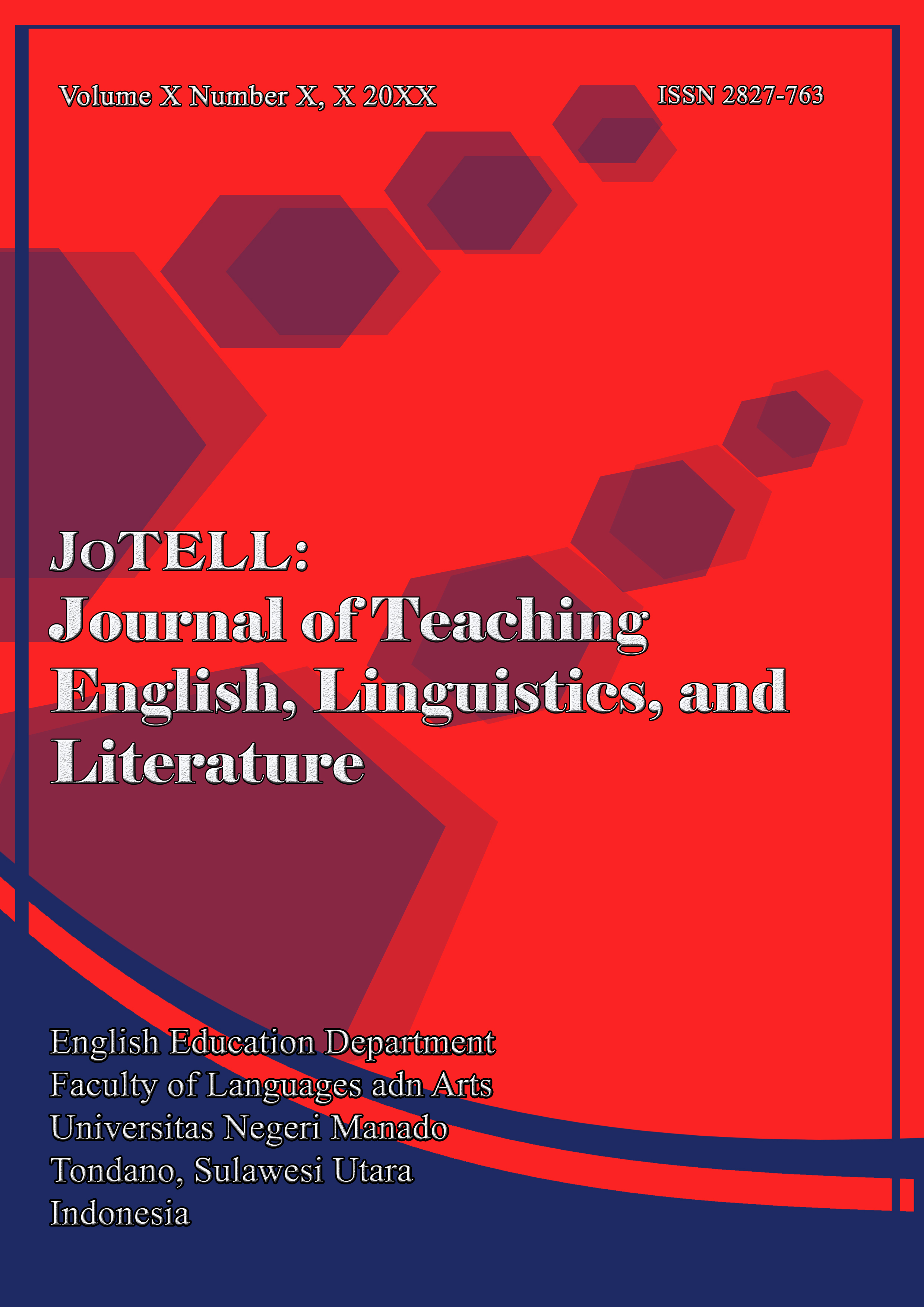Improving Students’ Reading Comprehension Using Fairy Tale Story at SMP Negeri 5 Lirung, Talaud Regency.
Reading, Skills, Fairy Tale Story, Eight Grade Students.
DOI:
https://doi.org/10.36582/jotell.v3i10.10405Abstract
English may be an all-inclusive dialect since it is utilized by most countries worldwide as the essential dialect. Dialect may be a communication instrument organized in units, such as words, bunches of words, clauses, and sentences communicated orally or in composing. Dialect is an extreme expression used to communicate something to others.This Research aimed to see the effectiveness of using fairy tales to improve student’s reading skills in the eighth grade of SMP Negeri 5 Lirung. This Research used a pre-experimental design with two groups, pre-test and post-test. This Research showed that Fairy Tale Story effectively improved students’ reading skills. The result showed that the post-test was higher than the pre-test. The mean score of the pre-test was 73.26, and the mean score of the post-test was 83.69, which means that the result of the post-test was higher than the pre-test. It can be stated that students’ reading skills in eighth grade of SMP Negeri 5 Lirung were high in the post-test. So it means Fairy Tale Story was effective in improving students’ reading skills in eighth grade of SMP Negeri 5 Lirung.
References
Arenseth, H. (2008). Activity theory and situated learning theory: Contrasting views of educational practice. Pedagogy, Culture & Society. 16(3), 289-302. https://doi.org/10.1080/14681360802346663O'Neill, R.S., Clark, D.V. (2013). Evolution of three parent genes and their retrogene copies in Drosophila species. Int. J. Evol. Biol. 2013(): 693085.
Cameron, Deborah. (2001). Working with Spoken Discourse. Oxford: SAGE Publications, Ltd.
Cohen, L., Manion, L. and Morrison, K. (2000). Research Methods in Education (5th ed.) London: Routledge.
Gani, sofyan. (2015). Students’ Learning Strategies for Developing Speaking Ability. SIELE Journal, Vol 2, 17-30.
Eckerth, J., &Tavakoli, P. (2012). The effects of word exposure frequency and elaboration of word processing on incidental L2 vocabulary acquisition through reading. Language Teaching Research, 16(2), 227-252.
Gersten, R., & Baker, S. (2000). What we know about effective instructional practices for English-language learners. Exceptional Children.
Hatch, Evelyn and Brown, Cheril. (1995). Vocabulary, Semantic, and Language Education. Australia: Cambridge University Press.
Hampp, Paula L. (2019). Use of Songs in Teaching Simple Tobe And Past Tense Teaching. Journal of English Language and Literature Teaching, 2019.
Harmer. Jeremy. 2002. The Practice of Language Teaching, New York: Pearson Education Limited
Heibert, Elfrieda H and Kamil, Michael L. (2005). Teaching and Learning Vocabulary. Edinburg: Portwell Publishing.
Huyen and Thu Nga. (2003). Learning Vocabulary through Games: The Effectiveness of Learning Vocabulary through Games. The Asian EFL Journal, vol. 5, article 6.
Richards, J. C. (2002). Theories of Teaching in Language Teaching. In J. C.Richards& W. A. Renandya (Eds), Methodology in language Teaching: Ananthology of current practice. (p.19- 26).Cambridge: Cambridge University Press.
Robert Lado. (1961). “Language testing :the construction and use of foreign language testâ€. Hongkong:Longman.
Rosia, AwitMariani. (2005). PenerapanMetode Peta Pikiran (Mind Mapping) dalamPembelajaranMenulisdalamUpayaMeningkatkanKeterampilanMenulis. Bogor: Polaris.
Snow, C. E., Griffin, P., & Burns, M. S. (Eds.). (2005). Knowledge to support the teaching of reading: Preparing teachers for a changing world. San Francisco, CA: Jossey-Bass.
Sugiyono. (2010). MetodePenelitianKuantitatif dan Kualitatif, Alfabeta, Bandung
Townsend, Tony. (2009). Thinking and acting both locally and globally: New issues for teacher education. Journal of Education for Teaching: International Research and Pedagogy.
Thornbury, Scott. (2002). How to Teach Reading. London: Longman
Willis, J.W. (2007). Foundations of Qualitative Research. Thousand Oaks, CA: Sage
Wolsey, T.D. (2014). Using technology in the upper elementary grades to support writing with digital media and sources. Newark, DE: International Reading Association.
Yule, George. (2006). The Study of Language. United States of America: Cambridge University Press, New York..
Downloads
Published
How to Cite
Issue
Section
License
Copyright (c) 2025 JoTELL : Journal of Teaching English, Linguistics, and Literature

This work is licensed under a Creative Commons Attribution-ShareAlike 4.0 International License.












